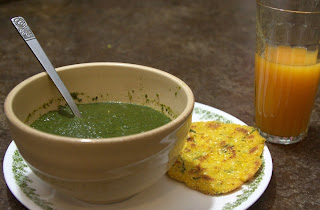Thursday breakfast
Another day, another breakfast of sweet potato hash browns. Can't beat 'em.
Thursday lunch
I started fixing today's lunch yesterday. Quinoa is a grain-like
[1] seed crop related to amaranth and beets. It is native to the Andes where the Incas called it the "mother of all grains." Not only does it have a delicious, nutty flavor, but it features a balanced set of essential amino acids, making it a good source of a complete protein. Brandon, the recent mountain intern, grew a demonstration size plot last year, which yielded about 6 quarts of seed heads.
Last night, I threshed these by rubbing them together between my hands to loose the seeds from the heads, and then dropping the mixture past a fan, which blew away the chaff, leaving the seeds behind. It was a little tricky getting the wind speed and drop distance just right to accurately separate out the seeds.
[2]
The end result was pretty satisfactory, though, even though the volume was diminished more than I'd expected - down to just one quart!
Luckily this was more than enough for the meal I had in mind: wait for it... quinoa wraps! But I'm getting ahead of myself.
If you buy quinoa in the store, you can cook it more or less like rice, without further processing. Most quinoa in the store, however, has already been soaked and rinsed before being re-dried. The reason this needs to be done is because raw quinoa is coated with saponins, chemical compounds that foam like soap when washed in water:
I rinsed the quinoa, soaked it in water for several hours (removing the floaters), rinsed it again, and then put it in the fridge for cooking the next morning. In the morning, I cooked it, and combined it with chopped cilantro, bunching onions, garlic chives, jalapeno pepper, lime juice, ground toasted pumpkin seeds, cherry tomatoes and fish beans (
Tephrosia vogelli). This mixture was served with broiled sweet potato sticks and blanched Wong Bok leaves (
Brassica rapa var.
pekinensis, related to Bok Choi) as a wrapper.
Since I had to sacrifice a pumpkin to access its seeds, I cut up the pumpkin and broiled it in a grapefruit and cane molasses glaze with crushed Brazilian red pepper seeds and dried chili peppers. For a drink, we mixed up some strawberry lemonade, sweetened with more cane molasses.
Thursday dinner
If you haven't noticed already, we have a lot of citrus available to us - not only in variety, but in quantity. Last night, we started marinating the goat meat for tonight's dinner. But firsts, the girls decided to juice some citrus. And by some, I mean a lot:
By the time we got around to marinating the goat, it was getting late, so we threw some goat ribs and stew meat into ziplock bags, poured some of our bounty of orange, lime, and grapefruit juice into the bags, and added some herbs: mint to the orange juice ribs, habanero peppers and tropical oregano to the lime juice ribs, and bunching onions and garlic chives into each bag. We also added a few slices of green papaya to each bag, as the enzyme papain, found in green papayas, has been utilized as a meat tenderizer for thousand of years. Into the fridge, and off to bed!
12 hours later, we rubbed the ribs with salt, transfered them to aluminum pans, and poured in a sauce made of goat broth, orange juice, cane molasses and hot peppers. After covering the pans, we baked them at 250 F all afternoon while we worked on the farm. By 4:30, the meat was falling off of the ribs. Ruth uncovered them, turning them once more at 5:30 so that they were nice and caramelized by the time the rest of dinner was ready at 6:30. These were truly among the best, most tender ribs I've ever had; those in the orange-mint marinade were especially sweet and scrumptious.
Meanwhile, the stew meat and soup bones were cooking all afternoon in broth along with bunching onions, garlic chives, turnips, sweet potato, daikon radishes, tropical oregano, Indian firecracker peppers, and other herbs.
At dinner time, we dipped into Andrew's sauerkraut that has been fermenting in the fridge. It's still pretty young (less than two weeks old), but already pleasantly sour.
The girls made a large lettuce, tomato and strawberry salad with a citrus-cilantro dressing:
And if that wasn't enough, Katie pulled out some fruit leather she had made by blending and drying papaya, bananas, citrus and prickly pear leaves:
With so much good food, we had to invite friends to share it with. Six volunteers, staff members and visiting missionaries joined us around the table for what was truly a feast. Given such a bounty, the term "farm challenge" seems inappropriate. Perhaps we should call this "farm feast week."
---
Reflections, day 5
Andrew noted that he's been dreaming a lot more at night this week. He attributes this to the fact that he's been eating fewer snacks after dinner, so all the blood usually bound up in the digestive process is now running to his head and giving him dreams. It's a theory.
Citrus and papaya marinated goat ribs are a win. I'm sure this week's diet wouldn't be quite as rich if we weren't eating our animals at such an unsustainable rate, but I think we could still eat off of the farm for much longer than a week without starving, become malnourished, or growing bored with our food. Though I'd probably miss cheese, bacon and bread after a while, I haven't started craving them yet... not while I'm getting a fresh glass of citrus juice with every meal!
---
[1] True grains, such as rice, wheat, corn and sorghum, come from grasses.
[2] I reckon the learning curve could have been shorter if this practice was part of our cultural knowledge, something people around me could have passed on.





















































